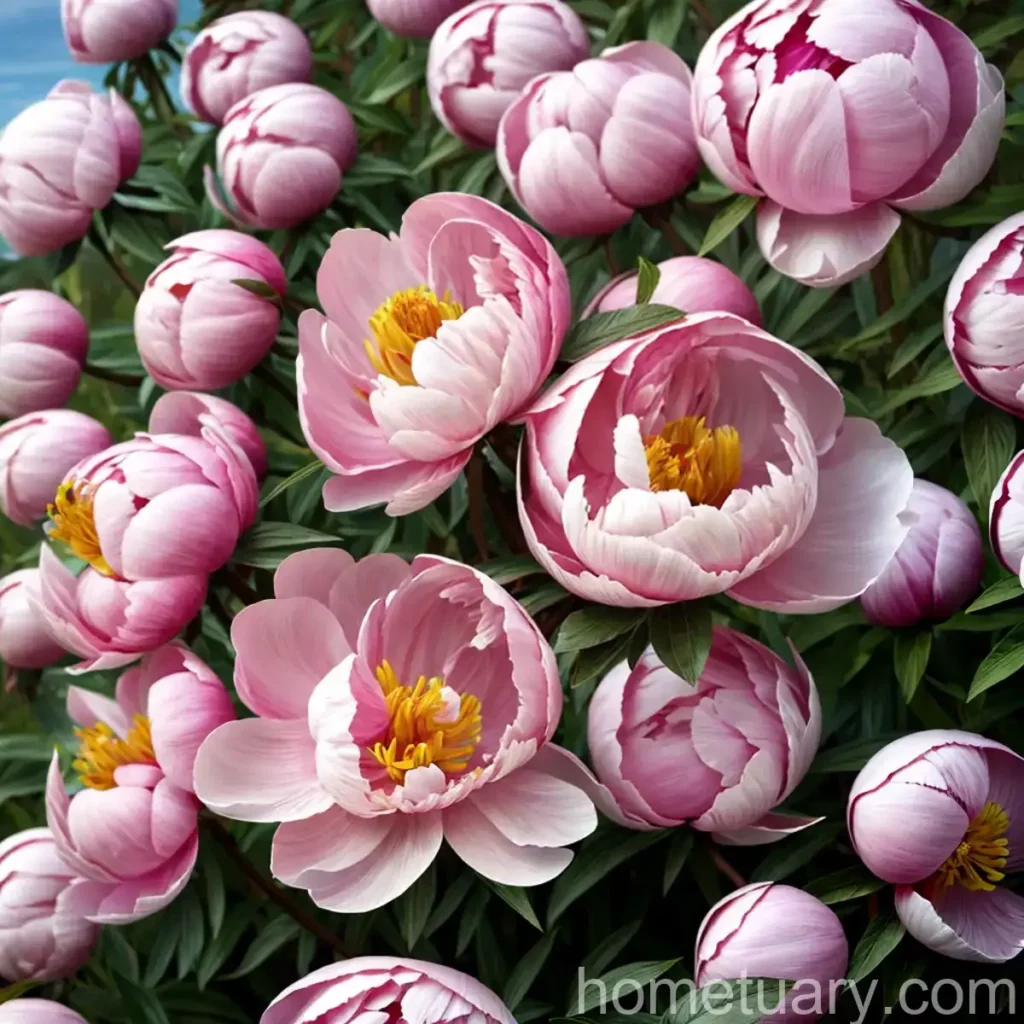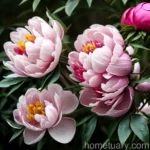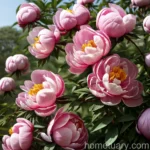Peony (Paeonia lactiflora ‘Mischief’): A Comprehensive Guide
Peonies are known for their stunning and fragrant blooms, and the Paeonia lactiflora ‘Mischief’ is no exception. In this comprehensive guide, we will delve into the culture, uses, and maintenance of this beautiful plant. Whether you are a seasoned gardener or a beginner, this guide will provide you with the essential information needed to cultivate and care for the ‘Mischief’ peony.
What is a Peony?
Peonies are herbaceous perennials that belong to the Paeoniaceae family. These plants are prized for their large, extravagant blooms and lush, deep green foliage. They are native to Asia, Europe, and Western North America. The Paeonia lactiflora, commonly known as the Chinese peony or common garden peony, is one of the most popular species in horticulture.
Peony (Paeonia lactiflora ‘Mischief’): An Overview
The Paeonia lactiflora ‘Mischief’ is a stunning herbaceous perennial that bears double, deep red flowers with a mild fragrance. This cultivar is known for its dramatic and eye-catching blooms, making it a favorite among gardeners and floral enthusiasts.
Key Takeaways – Peony (Paeonia lactiflora ‘Mischief’)
Before we delve into the specifics of cultivating and caring for the ‘Mischief’ peony, let’s take a look at the key takeaways that will be covered in this guide:
- Peony Varieties: Understanding the different types of peonies and their unique characteristics.
- Peony Plant Care: Essential tips for maintaining healthy and thriving peony plants.
- Peony Flower Facts: Exploring interesting facts and trivia about peony flowers.
- Paeonia lactiflora ‘Mischief’: A detailed look at the characteristics of the ‘Mischief’ peony cultivar.
- Mischief Peony Characteristics: Specific attributes and traits that set the ‘Mischief’ peony apart from other varieties.
- Growing Peony Plants: Best practices for successfully growing peonies in a garden or landscape.
- Peony Garden Tips: Helpful advice for creating a stunning peony garden.
- How to Cultivate Peonies: Step-by-step guidance on cultivating healthy and vibrant peony plants.
- Best Soil for Peonies: Understanding the soil requirements for optimal peony growth.
- Peony Planting Guide: Detailed instructions for planting peonies to ensure successful establishment.
- Tips for Peony Maintenance: Essential maintenance tips to keep peonies flourishing throughout the seasons.
- Peony Flower Arrangements: Inspiration and guidelines for creating beautiful floral arrangements with peonies.
- Peonies in Bouquets: Leveraging the beauty and charm of peonies in stunning bouquets and floral displays.
- Peony Symbolism: Exploring the cultural and symbolic significance of peonies.
- Peony Blooming Season: Understanding the blooming patterns and seasons of peonies.
- Peony Disease Prevention: Proactive measures to prevent diseases and ailments in peony plants.
- Common Peony Pests: Identification and management of pests that can affect peony plants.
- Pruning Peonies: Best practices for pruning peonies to promote healthy growth and abundant blooms.
- Peony Winter Care: Essential care guidelines to protect peonies during the winter months.
- Peony Fertilizer Requirements: Understanding the nutritional needs of peonies and how to fulfill them.
- Companion Plants for Peonies: Ideal companion plants to complement and enhance the beauty of peonies.
- Peony Colors and Varieties: Exploring the diverse array of colors and varieties available in peonies.
- Peony Root Division: Understanding the process of dividing peony roots for propagation and rejuvenation.
- Transplanting Peonies: Guidelines for successfully transplanting peonies to new locations.
- Peony Medicinal Uses: Exploring the historical and contemporary medicinal uses of peonies.
- Peony Cut Flower Tips: Tips and tricks for harvesting and arranging peony blooms as cut flowers.
- Peony Scent: Exploring the delightful fragrances associated with peony flowers.
- Peony Hybridization: Understanding the process of hybridizing peonies to create new cultivars.
- History of Peony Cultivation: A historical perspective on the cultivation and appreciation of peonies.
- Peonies in Asian Culture: Examining the cultural significance of peonies in Asian traditions and heritage.
- Peony Wedding Flowers: The role of peonies in weddings and celebrations as iconic floral elements.
- Drought-Tolerant Peonies: Identifying peony varieties that are resilient in dry and arid conditions.
- Deer-Resistant Peonies: Peony cultivars that are less susceptible to damage from deer.
- Shade-Tolerant Peonies: Varieties of peonies that thrive in shaded environments.
- Sun-Loving Peonies: Understanding the sunlight requirements for peonies to thrive.
- Peony Propagation Methods: Exploring different techniques for propagating peony plants.
- Growing Peonies from Seeds: Step-by-step guidance on growing peonies from seeds.
- Peony Landscape Design Ideas: Using peonies as focal points in landscape design and garden planning.
- Peony Border Plants: Ideal border plants and companion species to complement peonies.
- Peony Plant Diseases: Identification and management of common diseases affecting peony plants.
- Prized Peony Cultivars: Highlighting exceptional and prized peony cultivars admired by enthusiasts.
- Peony Garden Arrangements: Inspiring and creative ways to arrange peonies in garden settings.
- Pest Control for Peonies: Effective measures for controlling pests and insects that affect peony plants.
- Peony Foliage Maintenance: Best practices for maintaining healthy and vibrant foliage in peony plants.
- Peony Petal Variations: Exploring the diverse shapes, colors, and patterns of peony petals.
- Peony Root Health: Understanding the importance of root health for the overall well-being of peony plants.
- Peony Fragrance Profiles: An exploration of the unique fragrances associated with different peony cultivars.
- Famous Peony Gardens Worldwide: Highlighting renowned gardens and landscapes celebrated for their peony collections.
- Traditional Peony Uses: Exploring traditional and cultural uses of peonies in different societies and settings.
- Peony Historical Significance: Understanding the historical and symbolic importance of peonies across cultures and civilizations.
Now, let’s delve into the specifics of cultivating and caring for the captivating ‘Mischief’ peony.
Culture
Understanding the cultural requirements of the ‘Mischief’ peony is essential for ensuring its successful growth and abundant flowering. From selecting the right location to providing the ideal soil conditions, a thoughtful approach to the cultural aspects can yield rewarding results.
Uses
Peonies have been cherished for their ornamental beauty and versatile uses. Whether adorning gardens, serving as cut flowers, or symbolizing special occasions, peonies have a rich tapestry of uses.
Garden Ornamental:
- Peonies are admired for their lush foliage and spectacular blooms, making them popular choices for ornamental garden displays.
Cut Flowers:
- The ‘Mischief’ peony is a prized selection for cut flower arrangements due to its bold and vibrant blooms.
Symbolic Significance:
- Peonies hold symbolic importance in various cultures and traditions, often representing prosperity, honor, and good fortune.
Water
Proper watering is crucial for the health and vigor of the ‘Mischief’ peony. Understanding the moisture requirements and implementing appropriate watering practices can contribute to robust growth and abundant flowering.
Watering Guidelines:
- Establishment Phase: During the initial establishment phase, ensure that the plant receives regular, consistent watering to promote root development. Monitor soil moisture and water when the top inch of soil feels dry.
- Seasonal Watering: In the growing season, maintain a regular watering schedule, particularly during dry spells. Provide deep, thorough waterings to penetrate the root zone.
- Avoid Waterlogging: While peonies require adequate moisture, it is essential to prevent waterlogging. Good drainage is vital to prevent waterlogged soil, which can lead to root rot and other issues.
- Winter Moisture: Ensure that the plant receives sufficient moisture in the fall before the onset of winter. Adequate hydration is essential for preparing the plant for dormancy.
Sunlight
The ‘Mischief’ peony thrives in locations with ample sunlight, although considerations for sun exposure can vary based on regional climate and specific environmental conditions.
Sunlight Requirements:
- Full Sun: Ideally, plant the ‘Mischief’ peony in a location that receives full sun, with at least 6 to 8 hours of direct sunlight daily.
- Partial Shade: In regions with intense summer heat, providing partial shade during the hottest part of the day can be beneficial. Protecting the plant from harsh afternoon sun can prevent stress and sunburn.
Fertilizer
Fertilizing peonies is essential for providing the necessary nutrients for robust growth and abundant flowering. Understanding the right timing and formulation of fertilizers is crucial for the ‘Mischief’ peony’s overall health.
Fertilization Guidelines:
- Spring Feeding: Apply a balanced, slow-release fertilizer in the early spring as new growth emerges. A formulation such as 10-10-10 can provide the essential nutrients without overwhelming the plant with excessive nitrogen.
- Avoid High Nitrogen: While nitrogen is essential for foliage growth, excessive nitrogen can inhibit flowering. Choosing a balanced fertilizer formulation can promote a healthy balance of foliage and blooms.
- Cease Feeding: Discontinue fertilization after mid-summer to avoid stimulating new growth that may be susceptible to late-season frost damage.
Soil
The soil composition and structure play a crucial role in the ‘Mischief’ peony’s overall health and performance. Understanding the soil requirements and making necessary amendments can create an ideal growing environment for the plant.
Soil Requirements:
- Well-Draining Soil: Peonies thrive in well-draining, loamy soil that prevents waterlogging and promotes healthy root development.
- pH Levels: The ideal pH for peonies ranges from 6.5 to 7.5. Conduct a soil test to assess the pH and make necessary amendments using lime or sulfur.
- Organic Matter: Amending the soil with organic matter such as compost or well-rotted manure can improve soil texture and fertility, providing a favorable growing medium for peonies.
Pruning
Pruning peonies is an essential maintenance practice that promotes healthy growth, prevents disease, and enhances flowering. Understanding the appropriate timing and techniques for pruning is crucial for the ‘Mischief’ peony’s well-being.
Pruning Guidelines:
- Spring Pruning: Remove any dead or diseased foliage in the early spring to reduce the potential for disease spread and to encourage new growth.
- Deadheading: After the blooming season, promptly remove spent blooms to redirect energy into the development of new buds and foliage.
- Winter Clean-Up: In the late fall, after the plant has gone dormant, remove any remaining foliage to prevent overwintering diseases.
Propagation
Propagating the ‘Mischief’ peony allows for expanding the plant’s presence in the garden or sharing its beauty with others. Understanding the different propagation methods and the appropriate timing for each technique can lead to successful propagation.
Propagation Methods:
- Division: Dividing mature peony plants in the early fall can be an effective method of propagation. Ensure that each division has several healthy buds and a robust root system for successful establishment.
- Root Cuttings: Taking root cuttings in the late fall or early spring can yield new plants with a similar genetic makeup to the parent plant. Ensure that the cuttings are taken from healthy roots to promote successful propagation.
Container Popularity
While peonies are traditionally planted directly in the garden, the ‘Mischief’ peony can also thrive and bloom beautifully in containers. Container gardening offers versatility and the ability to showcase the plant’s splendor on patios, balconies, or other outdoor spaces.
Advantages of Container Planting:
- Versatility: Container-planted peonies can be moved and positioned to enhance outdoor spaces and complement garden displays.
- Space Constraints: For individuals with limited garden space or those residing in urban areas, container planting offers the opportunity to cultivate and enjoy the ‘Mischief’ peony.
- Visual Impact: The lush foliage and striking blooms of the ‘Mischief’ peony can serve as captivating focal points in container displays.
Common Diseases
While peonies are relatively low-maintenance plants, they are susceptible to certain diseases that can affect their overall health and flowering performance. By understanding common diseases and their symptoms, gardeners can take proactive measures to prevent and manage these issues.
Disease Diagnosis:
- Botrytis Blight: This fungal disease can cause gray mold on peony foliage and flowers, particularly in wet and humid conditions. Provide good air circulation and avoid overhead watering to prevent botrytis blight.
- Powdery Mildew: Recognized by the powdery white patches on foliage, powdery mildew can affect peonies. Improve air circulation and maintain proper spacing between plants to reduce the risk of powdery mildew.
- Leaf Spot: Dark lesions or spots on peony leaves may indicate the presence of leaf spot disease. Remove and dispose of infected foliage to prevent the spread of the disease.
Common Pests
In addition to diseases, peonies can also attract certain pests that may negatively impact their growth and flowering. Recognizing common pests and implementing effective pest management strategies is essential for preserving the ‘Mischief’ peony’s health.
Pest Control Measures:
- Aphids: These small, sap-sucking insects may appear on peony buds and younger foliage. A strong blast of water or insecticidal soap can help manage aphid infestations.
- Nematodes: Soil-dwelling nematodes can affect peony roots, leading to stunted growth and declined vigor. Planting nematode-resistant varieties and maintaining healthy soil conditions can help mitigate nematode issues.
Botanist’s Tips
1. Soil Preparation: Before planting the ‘Mischief’ peony, ensure that the soil is well-draining and rich in organic matter. Amending the soil with compost and aged manure can create an optimal growing environment.
2. Proper Spacing: When planting multiple ‘Mischief’ peony plants, provide adequate spacing between each plant to encourage good air circulation and prevent overcrowding.
3. Winter Protection: In regions with harsh winters, apply a layer of mulch around the base of the plant to insulate the roots and protect them from freezing temperatures.
4. Support for Blooms: As the ‘Mischief’ peony produces large and heavy blooms, providing support such as peony rings or stakes can prevent the stems from bending or breaking under the weight of the flowers.
Fun Facts
- Peonies have a rich history and cultural significance, particularly in Chinese culture, where they are regarded as the “king of flowers” and symbolize wealth, honor, and nobility.
- The name “peony” is derived from the Greek mythological figure Paeon, who was a student of Asclepius, the god of medicine. Paeon used the peony plant to heal Pluto, the ruler of the underworld, and for this act, he was transformed into the peony flower by Zeus to protect him from his teacher’s jealousy and anger.
Now that we have explored the essential aspects of cultivating and caring for the ‘Mischief’ peony, let’s take a look at some valuable external resources that can further enhance your knowledge and appreciation of this magnificent flowering plant.
Links to External Resources
- The American Peony Society: A reputable organization dedicated to the cultivation, appreciation, and conservation of peonies.
- Royal Horticultural Society – Growing Peonies: An informative guide from the Royal Horticultural Society offering valuable insights into growing peonies.
- University of Missouri Extension – Peonies in the Garden: A comprehensive publication from the University of Missouri Extension providing in-depth information on peony cultivation and care.
- The Plant Pathology Department at Cornell University – Peony Diseases: An educational resource offering detailed insights into common peony diseases and management strategies.
- The North American Butterfly Association: This resource highlights the role of peonies as nectar plants for butterflies, underscoring their ecological importance.
In conclusion, the ‘Mischief’ peony, with its captivating blooms and stunning visual appeal, is a true gem in the world of flowering plants. By understanding the cultural requirements, maintenance practices, and the unique attributes of this cultivar, gardeners can cultivate and cherish this exceptional plant. Whether gracing a garden border, adorning a floral arrangement, or serving as a focal point in a landscape, the ‘Mischief’ peony is a timeless symbol of beauty and elegance.
By embracing the botanist’s tips, understanding the needs of the ‘Mischief’ peony, and leveraging valuable external resources, gardeners can foster a deeper appreciation for this enchanting flowering plant and create thriving, vibrant garden spaces that celebrate the splendor of peonies.















